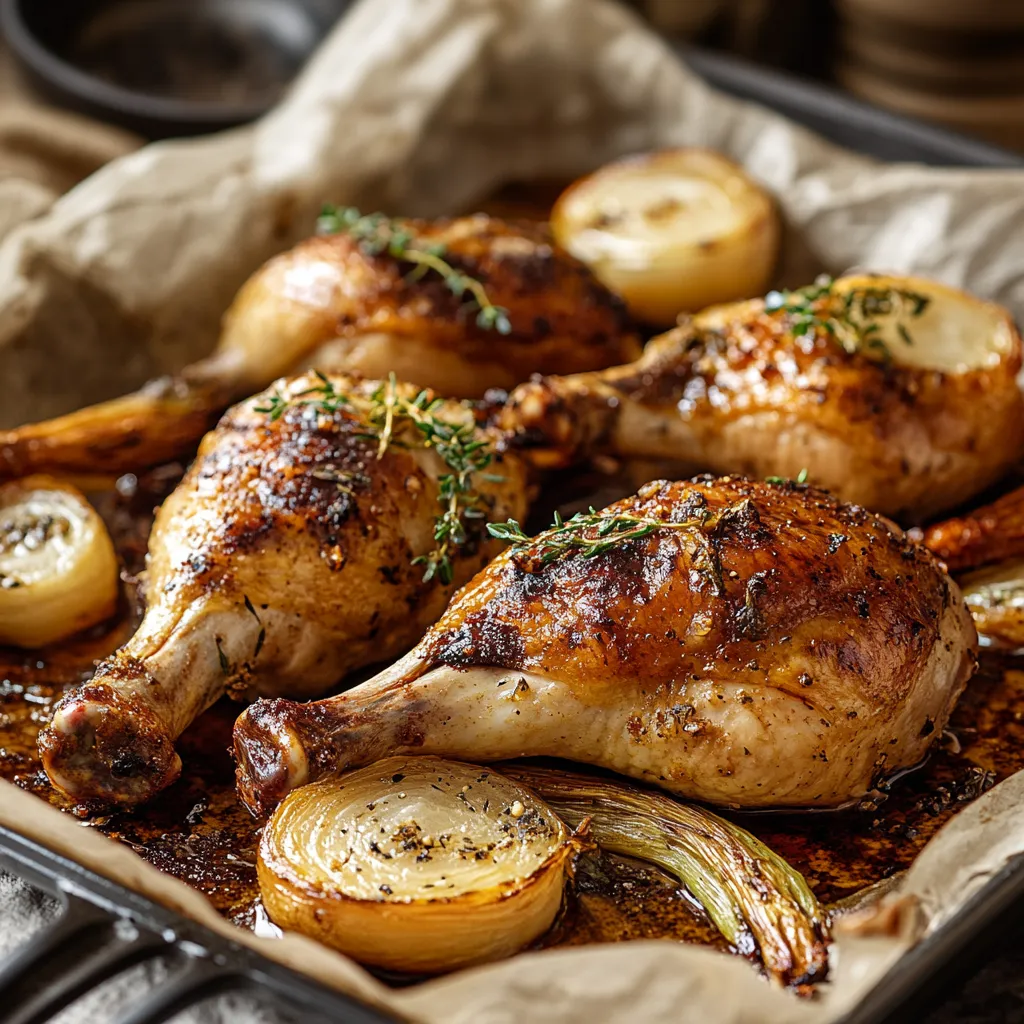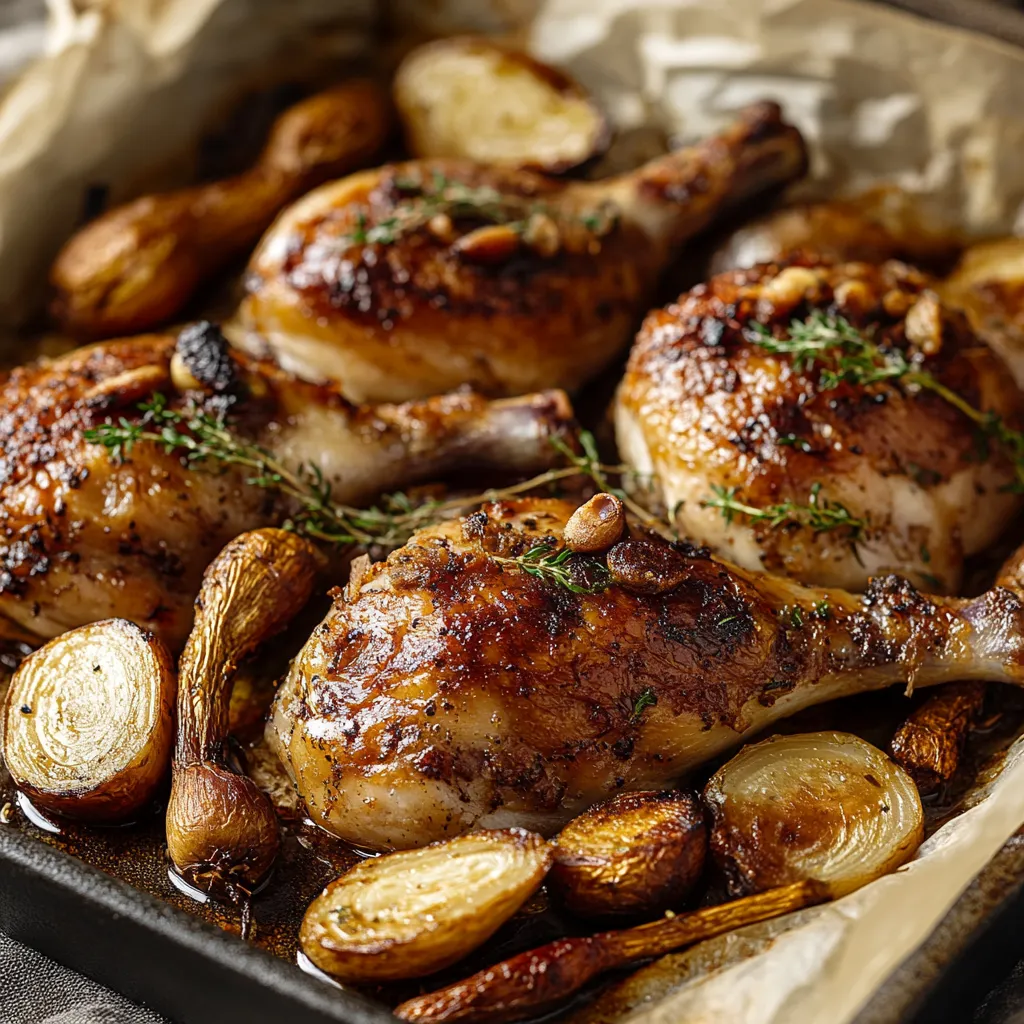 Save
Save
This slow-roasted duck leg recipe creates meat so flavorful and tender that it practically falls off the bone plus you get crackling golden skin and a tray full of sweet roasted roots. It is my go-to for lazy winter Sundays or when I really want to impress without fussing over dinner all evening.
Every time I make this my family hovers in the kitchen just waiting for the crispy skin I once had to fend off the last piece from my youngest who now claims duck as his favorite dinner
Ingredients
- Duck legs: whole skin on four pieces the key to rich flavor and perfect texture look for plump legs with a thick layer of skin and fat
- Yellow onion or turnips: either one cut thinly to create a flavor base pick onions that are firm and sweet or earthy turnips without blemishes
- Garlic cloves: four pieces smashed for mellow aromatic sweetness choose fat cloves that feel heavy for their size
- Fresh thyme: six to eight sprigs brings floral woodsy notes use bright green stems free from wilting
- Salt and freshly cracked black pepper: enhances every element I like flaky salt for crisp skin and freshly ground pepper for brightness
- Duck fat or olive oil: one tablespoon if needed helps brown the vegetables especially if the duck is on the leaner side opt for pure duck fat from the butcher if you can get it
Step-by-Step Instructions
- Dry and Season the Duck:
- Pat duck legs very dry with paper towels to help the skin crisp later Score just the skin with a sharp knife using a shallow diagonal pattern but do not pierce the meat This allows the fat to render out Season the duck all over with salt pepper and a pinch of thyme working seasoning into the cuts
- Prepare the Vegetable Bed:
- Arrange the sliced onion or turnip evenly in a baking dish Add the smashed garlic cloves and whole thyme sprigs If the duck legs are lean drizzle some olive oil or duck fat Toss everything gently with your hands so the aromatics are well distributed
- Arrange and Roast:
- Place the duck legs skin side up right on top of the vegetable bed Make sure the legs are not crowded or overlapping Transfer the dish to a preheated oven set at three hundred Fahrenheit Roast uncovered for two to two and a half hours Occasionally spoon the rendered duck fat over the legs and vegetables to maximize flavor and color
- Crisp the Skin:
- Increase oven temperature to four hundred twenty five Fahrenheit for the last twenty to twenty five minutes Watch carefully and rotate the dish if needed The skin should blister and become deeply golden If making ahead this step can be done just before serving
- Plate and Serve:
- Scoop caramelized onion or turnip onto each plate and top with a duck leg Remember to spoon over some of the buttery pan juices Add a sprig of fresh thyme for a pretty touch or dust lightly with flaked sea salt at the table
 Save
Save
The scent of fresh thyme is my favorite memory from this dish The aroma always fills the house and reminds me of Sunday dinners growing up when we would all stop to admire the golden color as the tray came to the table
Storage Tips
Once cooled store duck and vegetables in an airtight container in your refrigerator for up to three days Reheat uncovered in a hot oven until both the duck and veggies sizzle and the skin is crisp again The leftover duck fat can be poured into a small jar and saved in the fridge use it to fry potatoes or flavor roasted vegetables
Ingredient Substitutions
If you cannot find duck legs chicken thighs will also work but they will cook a bit faster For extra fragrance rosemary or sage can replace thyme Try swapping in carrots or parsnips with the onion or turnip If you enjoy bolder flavor a splash of dry white wine under the duck adds depth
Serving Suggestions
Serve with creamy mashed potatoes or roasted root vegetables for a comforting main I like a simple bitter greens salad on the side to cut through the richness For a more celebratory meal add apple wedges near the end of cooking or stir through a spoonful of grainy mustard into the pan juices
Cultural and Historical Context
Roasting duck legs in their own fat has roots in classic French farmhouse cooking especially in the southwest where confit and slow roasting are time honored traditions Using the whole duck and capturing every drop of rendered fat was a way to preserve precious pantry items Long slow roasting also ensures the luxurious crispy skin that makes this dish so beloved
Recipe FAQs
- → Do I need to sear the duck legs before roasting?
No, slow roasting allows the fat to render gradually and crisp the skin without searing first.
- → Can I substitute other herbs for thyme?
Absolutely. Rosemary or sage complement the flavors of duck wonderfully as alternatives.
- → How do I ensure extra crispy skin?
For extra crispiness, finish the duck under the broiler for 1–2 minutes, watching closely to avoid burning.
- → What vegetables work best beneath the duck?
Thinly sliced onions or turnips are ideal, but carrots, parsnips, or even apples offer delicious variation.
- → How should leftovers be stored and reheated?
Store cooled duck in the fridge up to 3 days. Reheat in a 350°F oven until hot and the skin is re-crisped.
- → Can I add additional flavors to the pan?
Try a splash of white wine or apple slices in the roasting dish for a sweet, aromatic touch.
